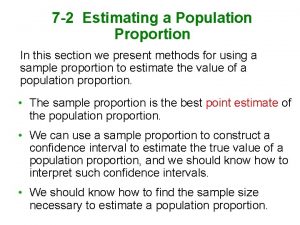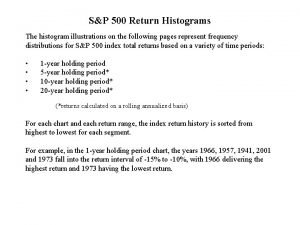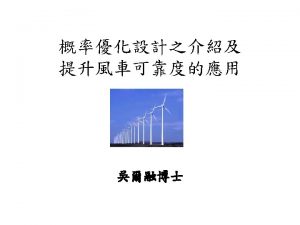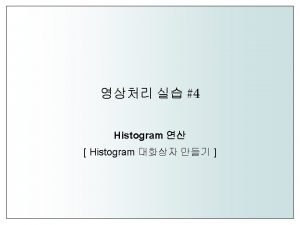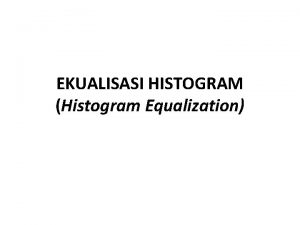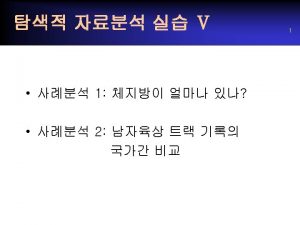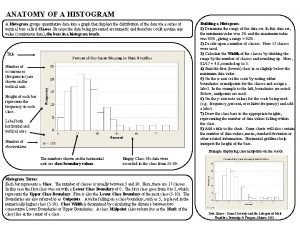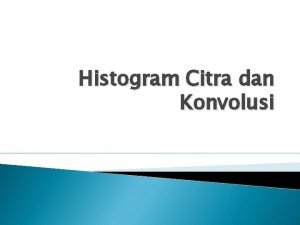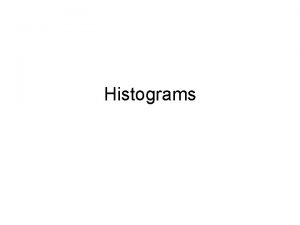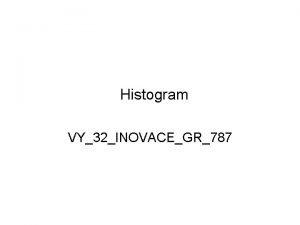Example Histogram c Interpret the following histogram that


![Interpreting the Histogram Bimodal, peaks at 27. 5 and 37. 5 [2. 5], one Interpreting the Histogram Bimodal, peaks at 27. 5 and 37. 5 [2. 5], one](https://slidetodoc.com/presentation_image_h/11112d7e7d2635a8e268d9c71816121d/image-3.jpg)










![Interpretation Supervised Scatter Plot The distribution of all three classes is unimodal [2] with Interpretation Supervised Scatter Plot The distribution of all three classes is unimodal [2] with](https://slidetodoc.com/presentation_image_h/11112d7e7d2635a8e268d9c71816121d/image-14.jpg)

- Slides: 15

Example Histogram c) Interpret the following histogram that captures the percentage of body-fat in a testgroup [4]:

On Interpreting I l Interpreting Histograms, Density Functions, distributions of a single attribute – – What is the type of the attribute? – – – Is the distribution skewed (e. g. compare mean with median)? What is the mean value; what is the mode? Is the a lot of spread or not (compute the standard deviation) Is the distribution unimodal (one hill or no hill)) or multi-modal (multiple hills)? Are there any outliers? Are there any duplicate values? Are there any gaps in the attribute value distribution? Characterize the shape of the density function! When comparing 2 histograms, identify agreements and significant differences in the density, gaps, local maxima, and density function slope.
![Interpreting the Histogram Bimodal peaks at 27 5 and 37 5 2 5 one Interpreting the Histogram Bimodal, peaks at 27. 5 and 37. 5 [2. 5], one](https://slidetodoc.com/presentation_image_h/11112d7e7d2635a8e268d9c71816121d/image-3.jpg)
Interpreting the Histogram Bimodal, peaks at 27. 5 and 37. 5 [2. 5], one gap/outlier at 45/50[1], somewhat skewed [0. 5], somewhat continuous, no large jumps in the frequency[1]; Tri-modal is also correct distinguishing between hills at 20 and 25 is also fine!

On Interpreting II l Interpreting Supervised Scatter Plots and Similar Display – Characterize the distribution of each class in the attribute space; is it unimodal or multi-modal? – Characterize the overall distribution (including all examples); do you observe any correlation or other characteristics? – Analyze the separation of a single class from all the other classes. Analyze the separation between pairs of classes. – If classes overlap characterize the extend to which they overlap and where they overlap in the attribute space – If decision boundaries between classes can be inferred characterize those decision boundaries. – Describe the region(s) where instances of each particular class are concentrated. – Assess the difficulty of the classification based on your findings of looking at a set of scatter plots. – Assess the usefulness of the two attributes to predict the correct class.

Body fat Histogram

On Interpreting I l Interpreting Histograms, Density Functions, distributions of a single attribute – What is the type of the attribute? Positive real numbers – What is the mean value; what is the mode? – Is the a lot of spread or not (compute the standard deviation)? Not much – Is the distribution unimodal (one hill or no hill)) or multi-modal (multiple hills)? One hill or two hills, depending on how you interpret the data. The second hill is not very well separated; therefore I would say unimodal. – Is the distribution skewed (e. g. compare mean with median)? – Are there any outliers? Yes values above 45…? – Are there any duplicate values? – Are there any gaps in the attribute value distribution? Yes two gaps: 1)… 2)… – Characterize the shape of the density function! Bell Curve

Comparing 2 Histograms Interpret the following 2 histograms and their relationships which describe the male and female age distribution in the US, based on Census Data.

Comparing 2 Histogram Comparison Both histograms: curves are continuous with no gabs or outliers, and somewhat smooth[1], bimodal with 2 (1? ? ; 0? ? ) not well separated maxima at 5 -19 and 3544 [1. 5], values significantly drop beyond age 55[1] skewed distribution Comparison: Curves are somewhat similar until age 55 [1] (although there are more males initially [0. 5]); e. g. shape of the density function and the 2 local maxima match; however, the decline in the male curve is significantly steeper: women live longer[1].

Scatter Plot Array of Iris Attributes

On Interpreting II (pedal length/width) l Interpreting Scatter Plots and Similar Display – Characterize the distribution of each class in the attribute space; is it unimodal or mult-imodal? Unimodal each. – Characterize the overall distribution (including all examples); do you observe any correlation or other characteristics? quite strong positive correlation between the two attributes. – Analyze the separation of a single class from all the other classes. Analyze the separation between pairs of classes. Blue is clearly separated from the two other; red and green only slightly overlap; – If classes overlap characterize the extend to which they overlap. – If decision boundaries between classes can be inferred characterize those decision boundaries. Test using just sepal length will mostly do a good job. – Assess the difficulty of the classification based on your findings of looking at a set of scatter plots. Easy

Example Supervised Scatter Plot d) Interpret the supervised scatter plot depicted below; moreover, assess the difficulty of separating signals and background using attributes x and y based on the scatter plot! [4]

Interpreting the Supervised Scatter Plot The signal class is centered in a single area (uni-modal) near (2. 5, -1) [1] the background class is centered in 2 areas (bi-modal) and focused in two separate regions at (0. 5, -2. 25) and (2, 0. 5) [1] with in-between regions dominated by red examples[0. 5]; the classes are separated although some overlap/contamination with example of other classes occurs, particularly near the boundaries [1]; the second region of the background class is very dense[0. 5] has a moon-like shape [0. 5] and is enclosed by region dominated by signal examples [0. 5]. The variable x seems to be more useful in separating the 2 classes; for example, most points less than 1 belong to the background class [1]; however, the variable y is still necessary to correctly classify the examples in moon-like dense are of the background class [0. 5].

Interpreting on More Supervised Scatter Plot Interpret the supervised scatter plot depicted below that consists of instances of 3 classes; moreover, assess the difficulty of separating instances of the 3 classes using attributes V 1 and V 7 based on the scatter plot! [7]
![Interpretation Supervised Scatter Plot The distribution of all three classes is unimodal 2 with Interpretation Supervised Scatter Plot The distribution of all three classes is unimodal [2] with](https://slidetodoc.com/presentation_image_h/11112d7e7d2635a8e268d9c71816121d/image-14.jpg)
Interpretation Supervised Scatter Plot The distribution of all three classes is unimodal [2] with no major gaps in the data density [0. 5]. Attribute V 7 is useful to separate the green class from the other 2 classes[1]; if V 1 is less than 1. 2 objects mostly belong to the green class[0. 5]; Attribute V 1 is useful to separate the purple class from the blue class[1]; all the example whose V 1 value is above 12. 8 are blue[0. 5]; additionally using attribute V 7 requiring that instances whose attribute values for V 1 that lie in [1. 2, 2. 2] leads to a even clearer distinction between the two classes [0. 5]. Moreover, using the fact that the V 1 value is a higher than 12. 2 for instances of the green class, leads to a clearer separation of the green and purple class [0. 5] By combining those rules [0. 5], the classification task should not be too difficult as the examples are well separated although there a few exceptions. [1] If they describe where the instances of the red, green, and purple are concentrated with respect to the V 1/V 7 coordinate system: [0. 5] for each description of the location of the three classes

Density Estimation l Examples and R-Code: https: //stats. stackexchange. com/questions/30788/whats-a-good-way-to-use-r-to-make-ascatterplot-that-separates-the-data-by-trea l Density estimation techniques where used to create the plots; the goal of density estimation is to generate a density functions for a given set of samples; usually, non-parametric density estimation approaches are used to create such density plots. l http: //en. wikipedia. org/wiki/Density_estimation l http: //en. wikipedia. org/wiki/Kernel_density_estimation l Parametric density estimation: http: //en. wikipedia. org/wiki/Maximum_likelihood
 Phân độ lown
Phân độ lown Block nhĩ thất độ 3
Block nhĩ thất độ 3 Thể thơ truyền thống
Thể thơ truyền thống Thơ thất ngôn tứ tuyệt đường luật
Thơ thất ngôn tứ tuyệt đường luật Walmart thất bại ở nhật
Walmart thất bại ở nhật Tìm độ lớn thật của tam giác abc
Tìm độ lớn thật của tam giác abc Con hãy đưa tay khi thấy người vấp ngã
Con hãy đưa tay khi thấy người vấp ngã Tôn thất thuyết là ai
Tôn thất thuyết là ai Gây tê cơ vuông thắt lưng
Gây tê cơ vuông thắt lưng Sau thất bại ở hồ điển triệt
Sau thất bại ở hồ điển triệt Ci value
Ci value Confidence interval z value
Confidence interval z value Critical value of 95 confidence interval
Critical value of 95 confidence interval Preparing to estimate a population proportion
Preparing to estimate a population proportion Sp annual returns
Sp annual returns Hát kết hợp bộ gõ cơ thể
Hát kết hợp bộ gõ cơ thể













